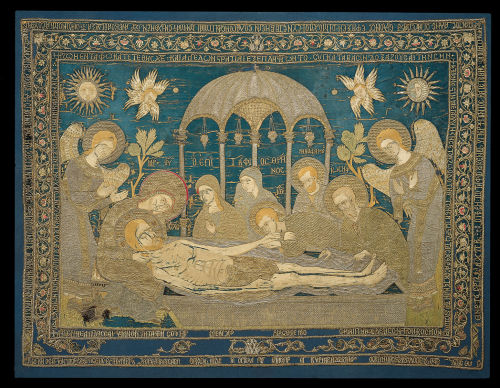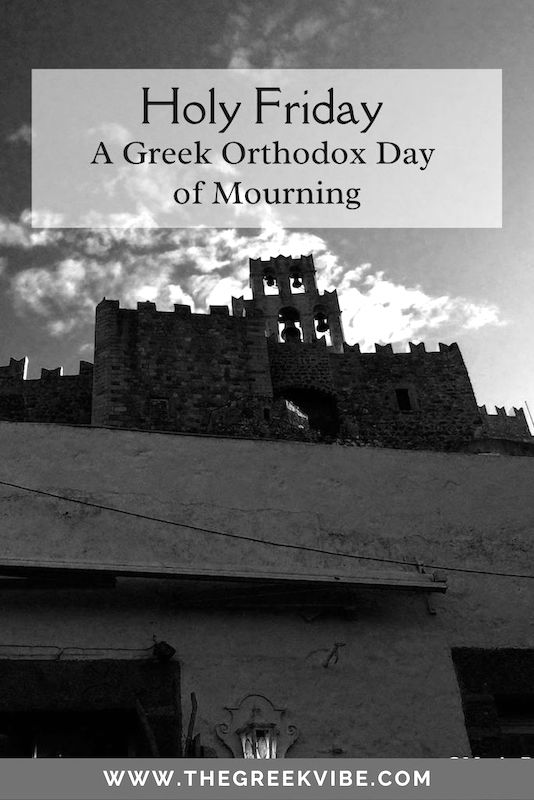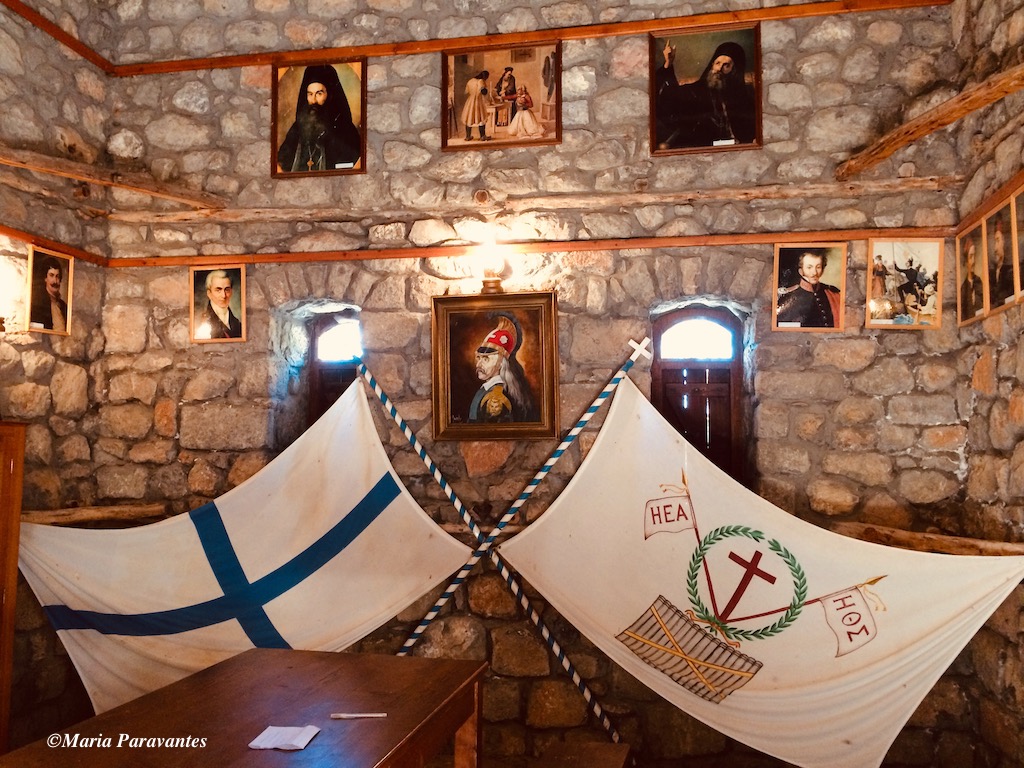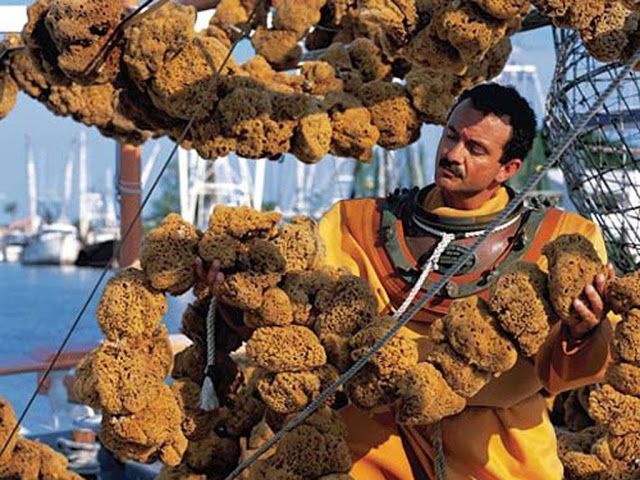
For the Greek Orthodox, Holy Friday (or “Megali Paraskevi”) is a day of loss and sorrow. A death knell echoes throughout Greece, from its remote villages to its buzzing cities. Flags are at half mast, and in the days of old, black cloths were hung from windows and balconies. On this day no activities are allowed. And in many remote villages, the only food allowed is vinegar, bread and olives.
For churches and chapels across Greece, Holy Friday is the most eventful time of the year. It marks the culmination of Christ’s Passion. In the morning, young children pick spring flowers – white for purity, red for life and purple for death – to decorate the bier which is covered in an elaborately carved wooden canopy (the “kouvouklion”) on which an embroidered fabric (the “epitaphios”) is placed.

According to Greek Orthodox beliefs, this embellished cloth represents the body of Christ and is placed on the bier after it is ceremoniously taken down from the cross. Sprinkled with rosewater and adorned with flower petals, the bier stands before the faithful, who have gathered for the “Egomia” (also known as the “epitaphios thrinos” or “lamentations”, composed of three hymns – “I Zoi en Tafo”, “Axion, Esti” and “E Genee Pase”) before the epitaphios is taken out of the church to be carried throughout town.
♪ On Holy Friday, this dirge (lament) is sung in the villages. It is a folk song about the sadness and grief of Holy Friday a day of mourning, the day of Christ’s Passions as he walks to his crucifixion at Golgotha – today the Church of the Holy Sepulcher. The song is titled “Today A Black Sky” (Simera Mavros Ouranos) and is also known as the “Lament of the Virgin Mary” (To Moiroloi tis Panagias). The song begins… “Today the sky is black, today the day is black, today everyone grieves and the mountains mourn.” Performed by one of Greece’s most celebrated folk (demotika) music singers: Chronis Aidonidis.
💡Where can I see the epitafios on Holy Friday in Greece?
The epitafios procession takes place in the evening after 8pm. You should arrive at the church around 7.30pm. Some of the churches in Athens for the unique Greek Easter experience include the Metropolitan Church, the Byzantine chapel of Kapnikarea in the historic center, and the more impressive Metochi of the Holy Sepulcher in Plaka (Metochi tou Panagiou Tafou). The candles on Holy Friday are not white because it is a day of mourning.
►Three Perfect Greek Easter Getaways
♪ One of the most beautiful is the first, titled “I Zoi en Tafo” (meaning “life in the grave”). Of all the deliveries, the most compelling, is by legendary Cretan troubadour, the late Nikos Xylouris, and singer Manolis Mitsias for Greece’s public broadcaster ERT in 1977.
►What Greeks Do on Orthodox Easter
Once the epitaphios procession begins, it is followed by the congregation holding dark candles and in many cases by the parish choir chanting the “Trisagion”, the town’s marching band performing a funeral march or even military units as the bells toll mournfully.

♪ This version is unique, in that it is delivered by a female, something very rare in the Orthodox religious experience, and not by a Greek. The great Lebanese singer Fairuz, the most respected artist of the Arab world, performs “I Zoi en Tafo” in this 1962 recording. The result is galvanizing.
In larger towns, where there are many parishes, each epitaphios is carried throughout the neighborhood only to merge with the others in the town’s central square.
👉🏼 Dream of visiting Greece? Start planning
♪ Here to the narration of actress Katerina Lechou and young performer Sofia Manou.
On many islands the processions come together on the port with the epitaphios often being carried into the sea.
♪ Here a traditional delivery by one of the country’s most acclaimed Byzantine music teachers, musicologist Simon Karas.
♪ And finally Greek band Trifono’s 2012 promising rendering …
Once the procession is over, the epitaphios is returned to the church. As Holy Saturday dawns, there is a soothing silence. Everyone is preparing for the Resurrection (Anastasi) service at midnight. The week of passions has passed, families unite, the devout hold white candles and when the lights go out, He Has Arisen, (Christos Anesti) – joy fills our hearts and even stronger an inner sense of hope… for we too, despite our trials, will spring to life.
Enjoyed this Post? Share and Pin it!




The wife and I arrive in Rhodes on Thursday night 2nd of May 2024. We will be staying in Hotel Ibiscus.
We would love to see the procession on Friday evening can anyone recommend the best Church we could locate to see this? Sorry its such short notice.
Hi, David. You should head to the Church of the Annunciation of the Theotokos in the old town. The epitafios service starts at 7.30pm but the procession begins at 10pm.Make sure to get a dark candle. https://maps.app.goo.gl/7U4kFT1HJxzJ7bD66
My dilemma: I arrive in Athens around 10 pm on Good Friday.
My hotel is near the Acropolis.
But I do not know which church to attend services.
I would appreciate your suggestions.
Hello, David. The actual procession takes place in the evening after 8pm. It would be good to be at the church around 7.30. Some of the churches near your hotel include the Metropolitan Church of Athens, the Byzantine chapel of Kapnikarea also in the historic center, and even more impressive the Metochi of the Holy Sepulcher in Plaka (Metochi tou Panagiou Tafou). The candles on Holy Friday are not white because it is a day of mourning.
Please understand, no one attending tonight’s most holy Good Friday services is “performing,” or doing ANYTHING for that matter aside from mourning the death of Jesus Christ, at His funeral, we do not “march” in procession, but are wearily woefully and yes led by the somber sound of the death toll, every 10 seconds that bell tolls, following slowly behind the Epitaphion -the casket holding His body, candles held in memorium to send our prayers to the heavens, its smoke carries our mourning heavy hearts’ prayers in mourning with sorrow and grief for they’ve killed the Son of God, we weep in lamentation for our Panagia, the Virgin Mary, who has lost her son, and ourselves, singing solemn & somber hymnals to comfort each other and grieve together, In a tomb they laid Him… I zoi en tafo cannot be sung without aching inside and tears,most of us in Christ’s funeral procession ARE crying tears, not performing, for we are AT his actual funeral service –
We pause together in prayer,singing our pleas, our blessings, our requests in joined chorus, “May His memory be eternal!” Over and over, woven in and out of choral rounds of I zoi en tafo, grieving together-our traditions are VERY intentional because death is a sacred passage to us, one we go in strong faith, and tonight’s service IS the funeral service of this man crucified today, and we must mourn this together-our Holy Friday service is absolutely even more beautiful amazing and moving than any show or performance an attendee may witness or observe, but that is only because attendance at Christ’s funeral, being witness to His death trampling death, IS the most amazing thing we may behold as men, EVER! May His memory be eternal! Kali Anastasi! May you all have the most blessed and beautiful celebrations of His resurrection!
Thank you very much Marianthie for your vivid and very true description of Holy Friday and the sadness of the day. Beautiful put. Christos Anesti and Chronia Polla.
Great insight! Thank you so much for sharing. Even though I’m Greek, I knew very little of all this.
That’s what we’re here for! To shed some light on Greek traditions, customs, and destinations very few people are aware of.